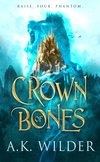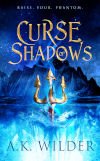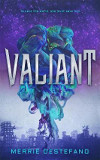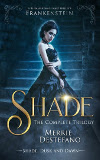 |
| White Rabbit as Trickster - Image by Caitlin Hackett |
Or maybe, Happy Wenut, forever live her Glory, with an Egyptian twang. Or, drawing on a popular neo-pagan deity, Happy Ostara?
There's no arguing that the rabbit is linked to the Christian tradition of Easter, but other than the mysterious triple hare symbol (seen above), there doesn't seem to be any connection prior to a few hundred years ago.
There are recent claims that Ostara, goddess of the dawn (eastern) light, took on the form of a rabbit and is associated with hares and eggs. It's not authenticated. The only ref to Ostara (Eostre) is from the Venerable Bede in his work The Reckoning of Time where he talked about calendar months.
All Bede said was that the pre-Christian celebration of “Easter” is predated by “Eostre” (another version of the name Ostara) who resided over the entire month of April.

That's it.
No rabbits.
No eggs.
No other description.
Hmmm ...
The rabbit may be a new addition to the accoutrement of Easter, but the symbolism is important - fertility, virgin births (rabbits can store sperm, birthing a litter long after the male is gone, which can seem miraculous) the season of Spring, abundance, renewal, wit, survival and my favourite - the Trickster.
The Trickster is an archetypal figure found in all cultures, in all places, in all times. She, or he, is both unconscious and super-conscious, hidden in our awareness and projected out into the world. And, sometimes that projection takes the form of a rabbit.
 |
| The Egyptian goddess Wenut |
When we get into such a state, the Trickster comes to blow the roof off the house, shaking our core, facilitating change. We fall in love, or make a radical decision, or have a sudden shattering to restore the flow of energy to our hearts.
We see the rabbit as trickster in literature, from the great rabbit in Watership Down, to Re're Rabbit in the West African rooted tale, from the White Rabbit in Lewis Carroll's Alice's Adventures in Wonderland to the resurrected Velveteen Rabbit.
So, is there a link to religious festivities, the Easter Bunny and hiding chocolate eggs? Consider Byrd Gibbens, Professor of English at University of Arkansas at Little Rock:
Many native traditions held clowns and tricksters as essential to any contact with the sacred. People could not pray until they had laughed, because laughter opens and frees from rigid preconception. Humans had to have tricksters within the most sacred ceremonies for fear that they forget the sacred comes through upset, reversal, surprise. The trickster in most native traditions is essential to creation, to birth.In a roundabout way, the rabbit as trickster, making an appearance at the time of Easter, has a certain circular symmetry to it - Rabbit --> Trickster --> Laughter --> upset --> contact with the sacred --> Rabbit --> Trickster ...
Something to think about as you bite off a choc-bunny head.
Hey, maybe even something to laugh about.
Happy Easter, Everyone!
Let me know your favourite rabbit in literature. After all, the Trickster is afoot!
xxxKim
Kim Falconer's latest release is out now - The Blood in the Beginning - and Ava Sykes Novel. Find this novel in a store near you.
You can also learn more about Kim at AvaSykes.com, the 11th House Blog, and on FaceBook and Twitter. Or on GoodVibeAstrology.com
She posts here at the Supernatural Underground on the 16th of every month and runs Save the Day Writer's Community on Facebook. Check out her daily Astro-LOA Flash horoscopes on Facebook.




























